Introduction
Before exploring How to Draft an Article 15 Legal Notice imagine this you’ve been denied admission to a college, rejected from a job, or unfairly treated solely because of your caste, religion, sex, or place of birth. It’s frustrating, isn’t it? In India, such discrimination isn’t just unfair—it’s unconstitutional. Thankfully, Article 15 of the Indian Constitution stands as a safeguard against this. But here’s the catch: simply knowing your rights isn’t always enough. To take real action, you often need to put your grievance into writing through a carefully drafted Article 15 legal notice.
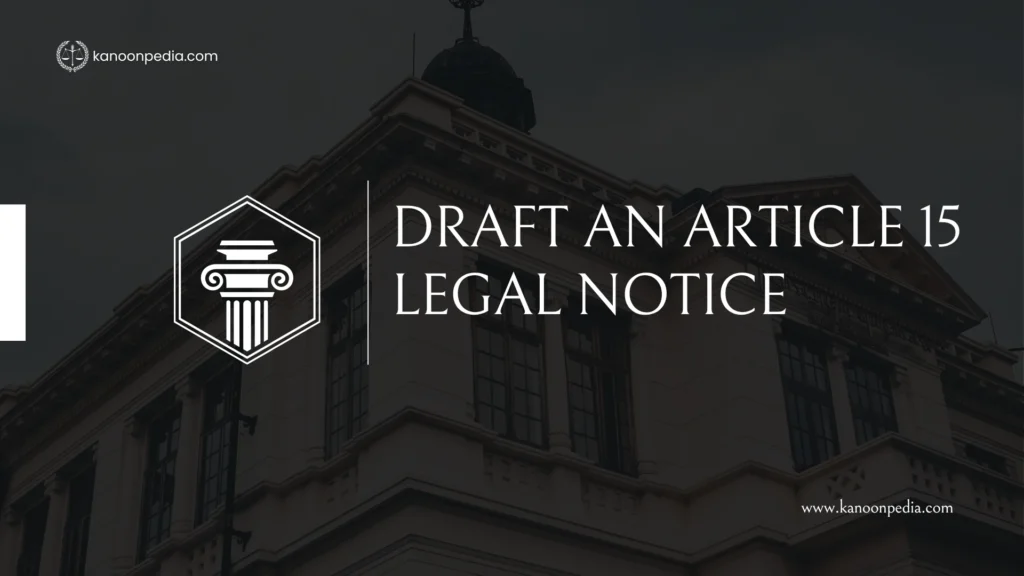
This blog is your step-by-step playbook to understanding and drafting an Article 15 legal notice like a pro. Whether you’re a law student, HR professional, or just someone who faced discrimination, this guide will walk you through the basics, practical drafting strategies, mistakes to avoid, and even provide you with a ready-to-use Article 15 legal notice template. Think of it as your smart friend explaining things in plain English—without the jargon.
Table of Contents
What is Article 15 of the Indian Constitution?
Article 15 is a part of the Fundamental Rights regime. It prohibits discrimination by the State on grounds of religion, race, caste, sex, or place of birth.
Fundamentally, this Article ensures that no citizen is denied access to public spaces, jobs, or educational opportunities due to their identity.
Quick Takeaway:
- Article 15 = Constitutional shield against discrimination.
- Legal notice under Article 15 = Formal assertion of this right in action.
Why Draft an Article 15 Legal Notice?
Many people directly rush to court when faced with discrimination. But a legal notice acts as a powerful pre-litigation step. It formally notifies the offender, provides an opportunity for correction, and strengthens your position if you later file a case.
Benefits:
- Creates a written record of your grievance.
- Gives the other party a last chance to comply.
- Shows the court that you tried amicable resolution first.
Bare Provision of Article 15
Here’s the bare text (Constitution of India):
Article 15(1): The State shall not discriminate against any citizen on grounds only of religion, race, caste, sex, place of birth or any of them.
Article 15(2): No citizen shall, on grounds only of religion, race, caste, sex, place of birth, or any of them, be subject to any disability, liability, restriction, or condition with regard to—
(a) access to shops, public restaurants, hotels, and places of public entertainment; or
(b) the use of wells, tanks, bathing ghats, roads, and places of public resort maintained wholly or partly out of State funds or dedicated to the use of the general public.
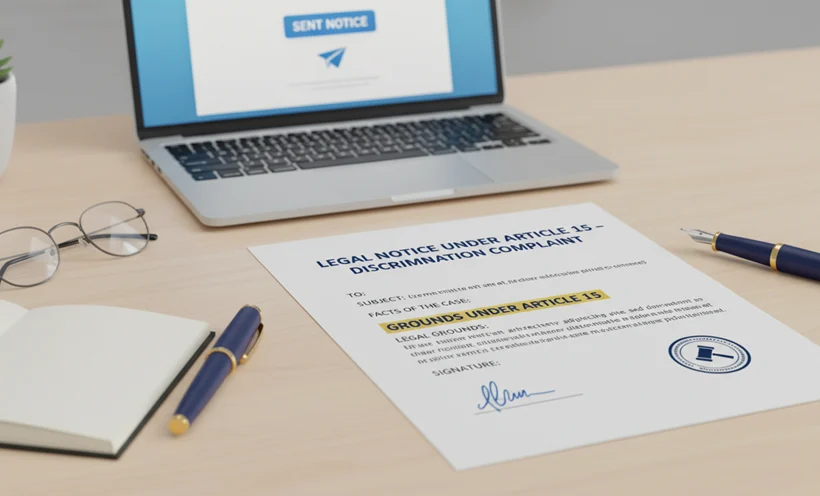
Key Elements of an Effective Article 15 Legal Notice
A strong Article 15 legal notice template always includes:
- Proper address of the authority or person.
- Clear facts describing the discrimination.
- Reference to Article 15 (and related judgments if possible).
- Demands/reliefs—such as reinstatement, apology, or compensation.
- Timeline for compliance (generally 15–30 days).
- Warning of legal action if ignored.
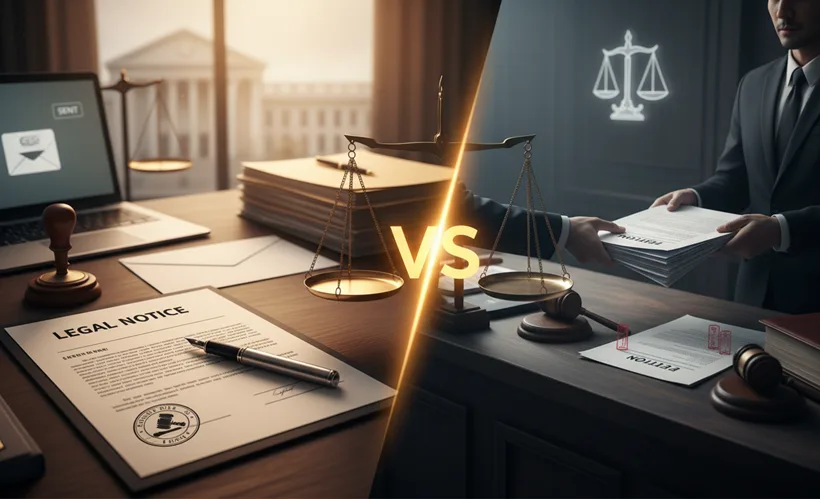
Think of it as telling a story with a legal edge: what happened, why it’s wrong, and what should be done.
Step-by-Step Guide to Drafting
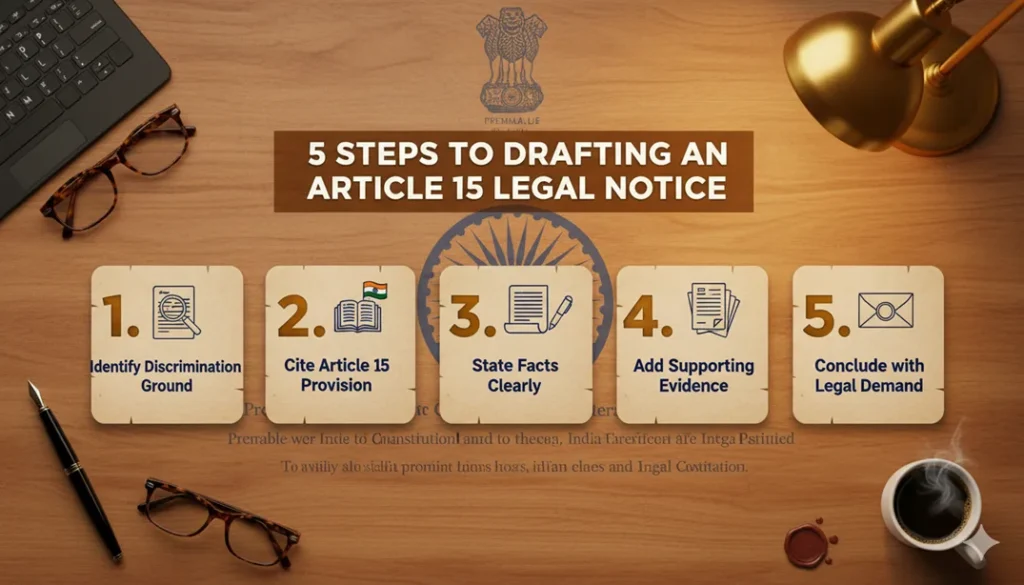
Addressing the Notice
Always direct it to the appropriate authority (school principal, employer, government office, etc.).
Stating the Facts
Keep it chronological and crisp. Example: “On 15th July 2025, I was denied entry into XYZ college solely due to my caste.”
Citing Legal Provisions
Mention Article 15 explicitly. You can even cite landmark cases like State of Madras v. Champakam Dorairajan (1951), which reinforced the anti-discrimination principle.
Relief/Demands
Be specific. Do you want reinstatement to a job? Withdrawal of discriminatory policy? Or a written apology?
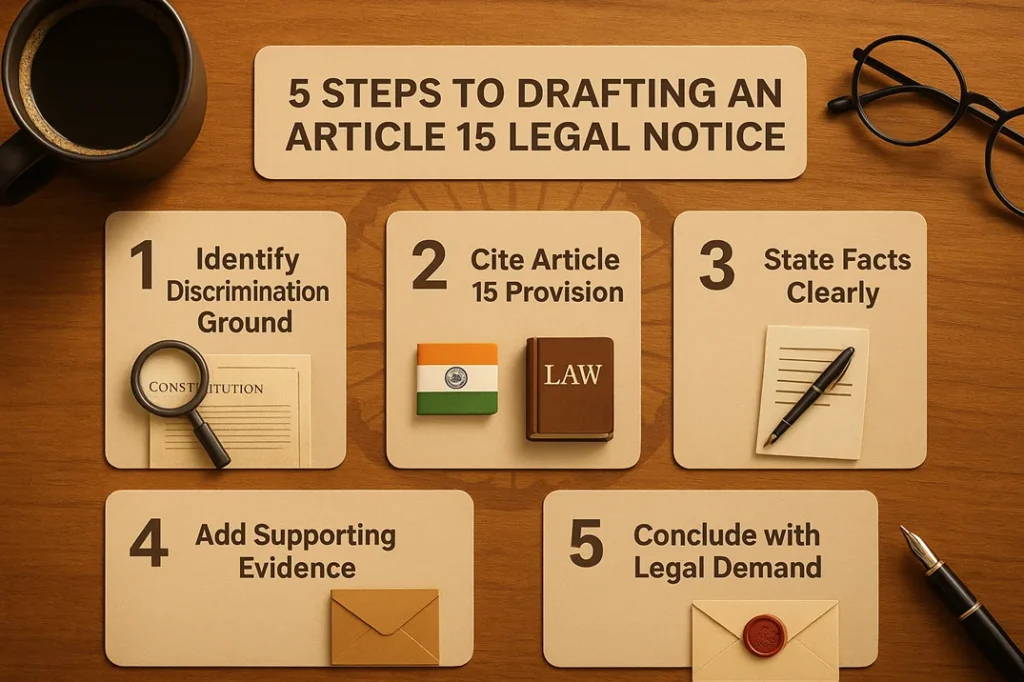
Time to Respond
Set a clear deadline: “within 15 days of receipt of this notice.”
Consequences of Non-Compliance
Make it clear that inaction will lead to writ petition, civil lawsuit, or other remedies.
Article 15 Legal Notice Template
Here’s a professional Article 15 legal notice template you can adapt:
textTo,
[Recipient’s Name & Designation]
[Organization/Address]
Subject: Legal Notice under Article 15 of the Constitution of India
Sir/Madam,
I am constrained to issue this legal notice as I have been subjected to discrimination solely on the grounds of [religion/caste/sex/place of birth].
On [date], I [explain incident briefly]. Such conduct is a direct violation of Article 15 of the Constitution, which prohibits discrimination in matters of access, opportunity, and participation.
I hereby call upon you to:
1. Immediately cease such discriminatory practices.
2. Provide written assurance that no such incident will recur.
3. [Other demands: e.g., admit me, reinstate my employment, extend equal access].
Kindly comply within 15 days of receipt of this notice, failing which I shall be constrained to initiate appropriate legal proceedings at your risk, cost, and consequence.
Sincerely,
[Your Full Name]
[Your Address]
[Contact Details]
[Signature]
Case Studies and Examples
- Case Study 1: Denial of Public Access
In 2015, a case was filed where students were denied entry to a public library for belonging to a marginalized caste. A legal notice drafted under Article 15 led to withdrawal of the discriminatory policy—without litigation. - Case Study 2: Workplace Bias
An IT professional issued a notice after being denied promotion based on gender. The company resolved it internally, averting a PR disaster.
Common Mistakes in Drafting (And How to Avoid Them)
- Being too emotional instead of factual.
- Forgetting to mention Article 15 explicitly.
- Not keeping proof of delivery (always send via registered post/email).
- Asking for vague outcomes instead of clear remedies.
Quick Takeaway:
Draft like a professional—factual, precise, legally grounded.
Did You Know? (Myth-buster Section)
- Myth: Article 15 only applies to government actions.
Fact: It also applies to private places open to the public (like hotels, shops). - Myth: You can’t take action without going to court.
Fact: A legal notice itself can often resolve issues.
Advanced Tips from Legal Experts
- Quote Supreme Court judgments to strengthen your notice.
- Always demand a written reply—helps in court later.
- Mention that you are prepared to move a writ petition under Article 32/226.
FAQs (People Also Ask)
- What is the purpose of an Article 15 legal notice?
It serves as a pre-litigation step to enforce your anti-discrimination rights. - Can I send an Article 15 legal notice without a lawyer?
Yes, but it’s advisable to get it vetted by a legal professional for accuracy. - What happens if the recipient ignores the notice?
You can file a writ petition or initiate legal proceedings. - Is Article 15 applicable against private employers?
Yes, if it concerns access, opportunity, or discriminatory regulations. - How long should I give for compliance?
Typically 15–30 days.
Quick Resources & Checklists
Checklist for Drafting
- Addressed correctly?
- Facts clear?
- Article 15 cited?
- Relief demanded?
- Deadline included?
- Proof of sending kept?
Conclusion & Call-to-Action
Drafting an Article 15 legal notice is not just about paperwork—it’s about asserting your dignity and rights. When you know the right framework, the process becomes clear and empowering.
If you’ve faced unfair treatment, don’t stay silent. Use this guide, adapt the template, and protect your fundamental rights effectively.
Have a question about your own situation? Drop a comment below or share this article—because awareness of rights spreads justice.
Author Bio
Adv. Arunendra Singh is an award-winning legal scholar, content strategist, and innovator who bridges traditional legal practice with emerging technologies. Currently at the National Law School of India University (NLSIU), Bangalore, he was honored with the President of India’s Award for exceptional academic and leadership achievements.
As Founder of Kanoonpedia, Arunendra has built a premier legal-education platform offering in-depth constitutional analyses, landmark case studies, and exam-focused guides. He is also Co-Founder of Clicknify, the “Anti-Agency Agency” for legal-tech startups. Using his proprietary Legal Clarity™ framework—which fuses doctrinal research, SEO-driven content architecture, and interactive study tools—he has elevated user engagement by over 70% and doubled session durations across both platforms.
In his consulting practice, Arunendra applies expertise in digital marketing and UX clarity audits to help edtech ventures achieve measurable growth through data-driven design and strategic conversion roadmaps. Trusted by top-tier law faculties, student associations, and early-stage startups, his hands-on workshops and advisory services have boosted organic traffic by 150% and transformed passive readers into active learners.
Connect with Adv. Arunendra Singh for thought leadership in legal innovation and technology law:
LinkedIn: https://www.linkedin.com/in/arunendrasingh31/